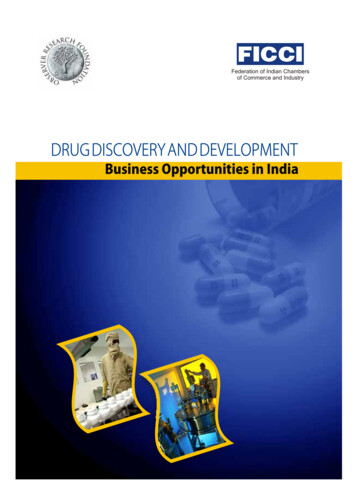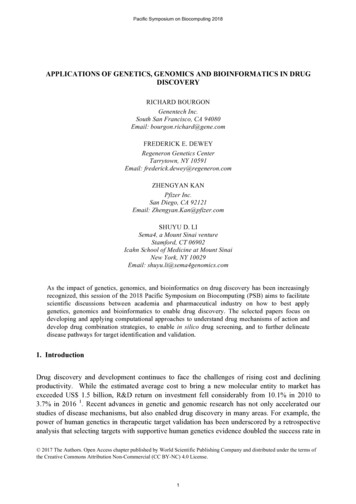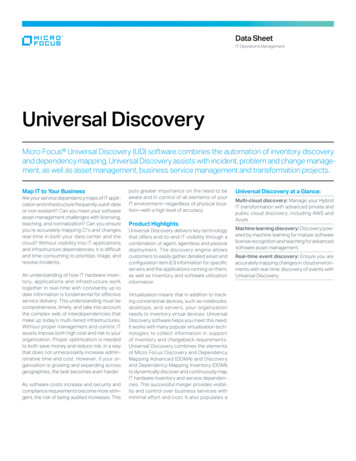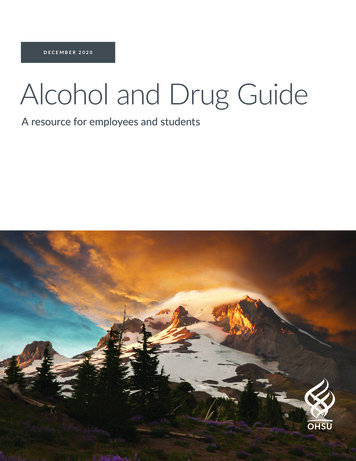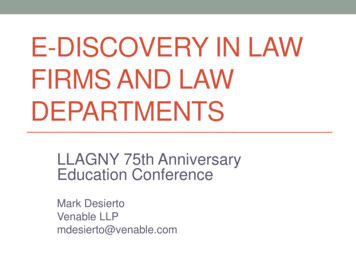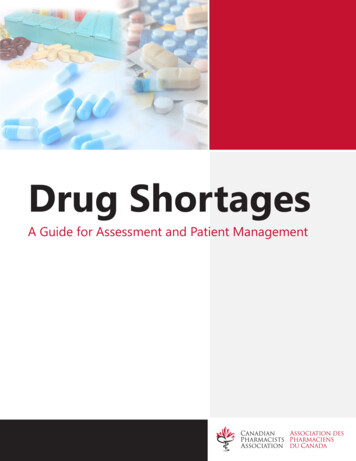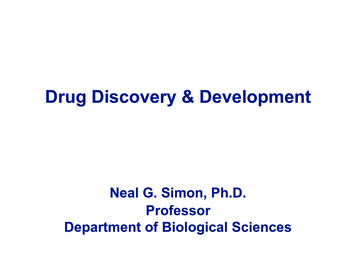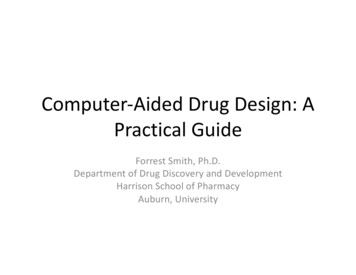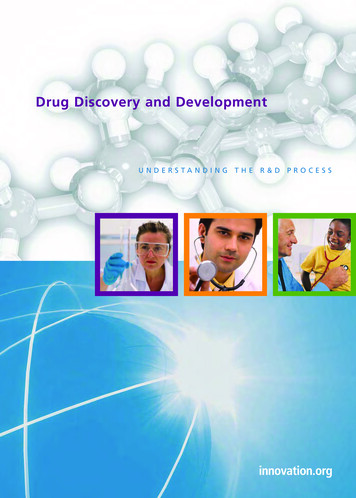
Transcription
Drug Discovery and DevelopmentUNDERSTANDING THE R&D PROCESS
We have an incredible wealth of knowledge thathas been generated over the past few years.”Thomas Hughes, Ph.D., NovartisOPEN TO: Review The ProcessPROCESS“This is a fantastic time to be doing drug discovery.DRUG DISCOVERY AND DEVELOPMENT: OverviewIt is the mission of pharmaceutical research companies to take thepath from understanding a disease to bringing a safe and effectivenew treatment to patients. Scientists work to piece together the basiccauses of disease at the level of genes, proteins and cells. Out of thisunderstanding emerge “targets,” which potential new drugs mightbe able to affect (see “How Drugs Work: The Basics” on p. 3).Researchers work to: validate these targets, discover the right molecule (potential drug) to interact withthe target chosen, test the new compound in the lab and clinic for safety andefficacy and gain approval and get the new drug into the hands of doctorsand patients.This whole process takes an average of 10-15 years.P U T T I N G I T I N T O P E R S P E C T I V E 15 yearsIt can take up to fifteen years to develop one newmedicine from the earliest stages of discovery to thetime it is available for treating patients. Many of thedrugs coming to the market in 2007 were in the earlystages of discovery fifteen years ago, in 1992.TVLet’s rewind the calendar to 1992 and take a look atwhat else was happening fifteen years ago.PoliticsWorld Events The Federal Republic of Yugoslavia, created in1918, collapses as Europe officially recognizes therepublics of Croatia and Slovenia. Signed by Canada, Mexico and the U.S., the NorthAmerican Free Trade Agreement establishes theworld's largest trading bloc.Top-Grossing Films Aladdin Home Alone 2: Lost in New York Batman Returns Jay Leno debuts as host of The Tonight Show. The last episode of The Cosby Show airs. Ted Turner, founder of CNN, is Time Magazine’sMan of the Year. Democrat Bill Clinton defeats incumbent U.S.President George H.W. Bush and businessmanH. Ross Perot.Sports Andre Agassi wins Wimbledon. The Washington Redskins defeat the BuffaloBills in Super Bowl XXVI.Technology The Internet Society is chartered, and 1,000,000host computers are connected in a network. Theterm "surfing the net" is coined as an increasingnumber of people begin exploring the online world. Compact discs surpass cassette tapes as thepreferred medium for recorded music.1
For the first time in history, scientists are beginning to understand the inner workings of humandisease at the molecular level. Recent advances ingenomics, proteomics and computational powerpresent new ways to understand illness. The taskof discovering and developing safe and effectivedrugs is even more promising as our knowledgeof disease increases. As scientists work to harnessthis knowledge, it is becoming an increasinglychallenging undertaking.SEQUENCING THE HUMAN GENOMEIn 2001 the sequencing of the human genomewas completed. There are about 20,000-25,000human genes, made up of 3 billion individualbase pairs, the units of DNA. Each gene codesfor a protein and these proteins carry out allthe functions of the body, laying out how itgrows and functions. These proteins can alsobe involved in disease.It takes about 10-15 years to develop onenew medicine from the time it is discoveredto when it is available for treating patients.The average cost to research and develop eachsuccessful drug is estimated to be 800 millionto 1 billion. This number includes the costof the thousands of failures: For every 5,00010,000 compounds that enter the research anddevelopment (R&D) pipeline, ultimately onlyone receives approval.These numbers defy imagination, but a deeperunderstanding of the R&D process can explainwhy so many compounds don’t make it andwhy it takes such a large, lengthy effort to getone medicine to patients. Success requiresimmense resources — the best scientific minds,highly sophisticated technology and complexproject management. It also takes persistenceand, sometimes, luck. Ultimately, though, theprocess of drug discovery brings hope and reliefto millions of patients.PROCESSDRUG DISCOVERY AND DEVELOPMENTThis page isFPO onlyWhy It’s a Big DealKnowing all the genes, and the proteins theycode for gives scientists a full catalogue ofoptions to consider as potential targets fornew drugs. It will take time, though, to achievethe potential benefits of this new knowledge.Although we have a list of all the genes, wedo not know how they all interact and whichare involved in which diseases.Eventually, scientists hope to discover newdrugs that precisely and powerfully preventand cure disease. The human genome holdsincredible potential.1
T HEDISCOVERY PROCESS INCLUDES ALL EARLY RESEARCH TO IDENTIFY A NEW DRUG CANDIDATE AND TESTINGIT IN THE LAB .T HEPROCESS TAKES APPROXIMATELY3-6YEARS .BYTHE END , RESEARCHERS HOPE TO HAVE APROMISING CANDIDATE DRUG TO TEST IN PEOPLE .THE DISCOVERY PROCESSPre-discoveryUnderstand the diseaseBefore any potential new medicine can be discovered, scientists workto understand the disease to be treated as well as possible, and tounravel the underlying cause of the condition. They try to understand how the genes are altered, how that affects the proteins theyencode and how those proteins interact with each other in livingcells, how those affected cells change the specific tissue they are inand finally how the disease affects the entire patient. This knowledgeis the basis for treating the problem.Researchers from government, academia and industry all contributeto this knowledge base. However, even with new tools and insights,this research takes many years of work and, too often, leads to frustrating dead ends. And even if the research is successful, it will takemany more years of work to turn this basic understanding of whatcauses a disease into a new treatment.“Some ideas may just stay on paper forever,PUBLIC AND PRIVATE CollaborationsModern drug discovery is the product ofcooperation. Many sectors contribute, particularly in building the basic science foundations. Both public and private organizations play unique but increasingly interdependent roles in translating basic researchinto medicine. Major biopharmaceutical companies arethe primary source of R&D funding fornew medicines, both for projects in theirown laboratories as well as for researchlicensed from other sectors. Smaller companies also drive innovation,conducting basic research, drug discovery,preclinical experiments and, in somecases, clinical trials. The National Institutes of Health (NIH)provides leadership and funding supportto universities, medical schools, researchcenters and other nonprofit institutions,and stimulates basic research and earlystage development of technologies thatenable further targeted drug discoveryand development.but others have a way forward to make it intoa pill, into a bottle at the pharmacy.”Debra Luffer-Atlas, Ph.D., Eli Lilly and Company23
HOW DRUGS WORKthe basicsThe cells in our bodies carry out complexmolecular reactions to perform everyfunction — from digesting your lunch,to moving your finger, to regulating cellgrowth and transmitting thoughts inyour brain. One type of molecule interacts with another which, in turn, affectsanother, and so on down the line. Thesecascades of molecular changes are calledchemical pathways.In many different and extremely complexways, these pathways are involved indisease. A mistake in one reaction mightstop an important protein from beingproduced or lead to too much production.These molecular imbalances can have bigconsequences. Maybe they will cause extracells to grow — like in cancer — or perhaps cause the person’s body to notproduce enough insulin — like in diabetes.Drug molecules affect these pathwaysby interacting with certain moleculesalong the pathway, making them moreactive or less active, or changing theiractivity all together.Target IdentificationChoose a molecule to target with a drugOnce they have enough understanding of the underlying cause of adisease, pharmaceutical researchers select a “target” for a potentialnew medicine. A target is generally a single molecule, such as a geneor protein, which is involved in a particular disease. Even at this earlystage in drug discovery it is critical that researchers pick a target thatis “drugable,” i.e., one that can potentially interact with and beaffected by a drug molecule.Target ValidationTest the target and confirm its role in the diseaseAfter choosing a potential target, scientists must show that it actuallyis involved in the disease and can be acted upon by a drug. Targetvalidation is crucial to help scientists avoid research paths that lookpromising, but ultimately lead to dead ends. Researchers demonstrate that a particular target is relevant to the disease being studiedthrough complicated experiments in both living cells and in animalmodels of disease.Drug DiscoveryFind a promising molecule (a “lead compound”)that could become a drugArmed with their understanding of the disease, scientists are readyto begin looking for a drug. They search for a molecule, or “leadcompound,” that may act on their target to alter the disease course.If successful over long odds and years of testing, the lead compoundcan ultimately become a new medicine.There are a few ways to find a lead compound:Nature: Until recently, scientists usually turned to nature to findinteresting compounds for fighting disease. Bacteria found in soiland moldy plants both led to important new treatments, forexample. Nature still offers many useful substances, but nowthere are other ways to approach drug discovery.De novo: Thanks to advances in chemistry, scientists can also create molecules from scratch. They can use sophisticated computermodeling to predict what type of molecule may work.High-throughput Screening: This process is the most common waythat leads are usually found. Advances in robotics and computational power allow researchers to test hundreds of thousands ofcompounds against the target to identify any that might be promising. Based on the results, several lead compounds are usuallyselected for further study.Biotechnology: Scientists can also genetically engineer living systems to produce disease-fighting biological molecules.23
“If at the end of my career, I can look back andknow that something I did made a difference in onepatient somewhere in the world, that’ll be moresatisfying and more gratifying than anything I canpossibly imagine.”LEAD OPTIMIZATIONat the molecular levelJonathan Yingling, Ph.D., Eli Lilly and CompanyEarly Safety TestsPerform initial tests on promising compoundsLead compounds go through a series of tests to provide an earlyassessment of the safety of the lead compound. Scientists testAbsorption, Distribution, Metabolism, Excretion and Toxicological(ADME/Tox) properties, or “pharmacokinetics,” of each lead.Successful drugs must be: absorbed into the bloodstream,distributed to the proper site of action in the body,metabolized efficiently and effectively,successfully excreted from the body anddemonstrated to be not toxic.New techniques have revolutionized theability of researchers to optimize potentialdrug molecules. Thanks to technologiessuch as magnetic resonance imaging andX-ray crystallography, along with powerfulcomputer modeling capabilities, chemistscan actually “see” the target in threedimensions and design potential drugs tomore powerfully bind to the parts of thetarget where they can be most effective. Inaddition, new chemistry techniques helpscientists to synthesize the new compounds quickly.These studies help researchers prioritize lead compounds early inthe discovery process. ADME/Tox studies are performed in livingcells, in animals and via computational models.Lead OptimizationAlter the structure of lead candidates to improve propertiesLead compounds that survive the initial screening are then “optimized,” or altered to make them more effective and safer. By changingthe structure of a compound, scientists can give it different properties.For example, they can make it less likely to interact with other chemical pathways in the body, thus reducing the potential for side effects.Hundreds of different variations or “analogues” of the initial leadsare made and tested. Teams of biologists and chemists work together closely: The biologists test the effects of analogues on biologicalsystems while the chemists take this information to make additionalalterations that are then retested by the biologists. The resultingcompound is the candidate drug.Even at this early stage, researchers begin to think about how thedrug will be made, considering formulation (the recipe for makinga drug, including inactive ingredients used to hold it together andallow it to dissolve at the right time), delivery mechanism (the waythe drug is taken – by mouth, injection, inhaler) and large-scalemanufacturing (how you make the drug in large quantities).45
“The number of people involved ingetting a drug to the first patient isa small phonebook. It’s hundreds toeven a thousand or two thousand,depending on the nature of thework. It requires people from awhole set of different disciplines,ranging from a geneticist who maybe that person who makes the firstlink of a gene with a disease, to thechemist who tried to understand howto make a chemical that will interactwith a protein, that a biochemist willhave isolated, to a pharmacist whowill figure out how to take thatchemical and put it into some kindof delivery device, what we call a pillor injection, to computer scientistswho work to try to predict how thatdrug is going to behave in a patientor in a large population, and so on.The set of disciplines is immense.”John Leonard, M.D., AbbottPreclinical TestingLab and animal testing to determine if the drug is safeenough for human testingWith one or more optimized compounds in hand, researchers turn theirattention to testing them extensively to determine if they should moveon to testing in humans.Scientists carry out in vitro and in vivo tests. In vitro tests are experiments conducted in the lab, usually carried out in test tubes andbeakers (“vitro” is “glass” in Latin) and in vivo studies are those inliving cell cultures and animal models (“vivo” is “life” in Latin).Scientists try to understand how the drug works and what its safetyprofile looks like. The U.S. Food and Drug Administration (FDA)requires extremely thorough testing before the candidate drug canbe studied in humans.During this stage researchers also must work out how to make largeenough quantities of the drug for clinical trials. Techniques for makinga drug in the lab on a small scale do not translate easily to larger production. This is the first scale up. The drug will need to be scaled upeven more if it is approved for use in the general patient population.At the end of several years of intensive work, the discovery phase concludes. After starting with approximately 5,000 to 10,000 compounds,scientists now have winnowed the group down to between one andfive molecules, “candidate drugs,” which will be studied in clinical trials.“The challenge of finding a new drug is an incredible thing. You’re trying to solve a complex disease with a single molecule. It’s an incrediblechallenge. We employ technologies that are just unbelievable in theirdepth and their complexity. At the end of day, we do this to bring somecomfort to people who are suffering and dealing with the anguish anddespair of a chronic disease. It’s to bring some hope to them.”Thomas E. Hughes, Ph.D., Novartis45
“I think we’ve only begun to scratch the surface in ourunderstanding of disease and the way we’re going tobe able to treat diseases. Many of us that are in theindustry now. I don’t think we can even conceive ofwhere it’s all going to go in the future, but there’s along, long way to go. We’ve only just begun.”Charles Gombar, Ph.D., WyethA CANDIDATE DRUG MUST GO THROUGH EXTENSIVE STUDIES IN HUMANS, AND IT MUST PROVE TO BE SAFE AND EFFECTIVEFDA WILL APPROVE IT. THIS PROCESS INVOLVES A SERIES OF CLINICAL TRIALS, EACH WITH ITS OWN SPECIFIC GOALSAND REQUIREMENTS. PHYSICIANS CARRY OUT EACH TRIAL WORKING WITH PATIENTS IN HOSPITALS, OFFICES AND CLINICS, ANDCOORDINATING CLOSELY WITH THE SPONSOR COMPANY. THE CLINICAL TRIALS PROCESS IS BOTH EXPENSIVE AND TIME-CONSUMING, AND ENDS MORE OFTEN IN FAILURE THAN SUCCESS. FROM START TO FINISH IT TAKES AN AVERAGE OF 6-7 YEARS.BEFORE THETHE DEVELOPMENT PROCESSInvestigational New Drug (IND) Application and SafetyFile IND with the FDA before clinical testing can begin;ensure safety for clinical trial volunteers through anInstitutional Review BoardBefore any clinical trial can begin, the researchers must file anInvestigational New Drug (IND) application with the FDA. The application includes the results of the preclinical work, the candidate drug’schemical structure and how it is thought to work in the body, a listingof any side effects and manufacturing information. The IND also provides a detailed clinical trial plan that outlines how, where and bywhom the studies will be performed.The FDA reviews the application to make sure people participating inthe clinical trials will not be exposed to unreasonable risks.CLINICAL TRIAL DESIGNAn incredible amount of thought goes intothe design of each clinical trial. To providethe highest level of confidence in the validity of results, many drug trials are placebocontrolled, randomized and double-blinded.What does that mean? Placebo-controlled: Some subjects willreceive the new drug candidate andothers will receive a placebo. (In someinstances, the drug candidate may betested against another treatment ratherthan a placebo.) Randomized: Each of the study subjects inthe trial is assigned randomly to one ofthe treatments. Double-blinded: Neither the researchersnor the subjects know which treatment isbeing delivered until the study is over.This method of testing provides the bestevidence of any direct relationship betweenthe test compound and its effect on diseasebecause it minimizes human error.The number of subjects enrolled in a trial(the “power” of the trial) also has to becarefully considered: In general, enrollingmore subjects results in greater statisticalsignificance of the results, but is also moreexpensive and difficult to undertake.In addition to the IND application, all clinical trials must be reviewedand approved by the Institutional Review Board (IRB) at the institutionswhere the trials will take place. This process includes the developmentof appropriate informed consent, which will be required of all clinicaltrial participants.Statisticians and others are constantly monitoring the data as it becomesavailable. The FDA or the sponsor company can stop the trial at anytime if problems arise. In some cases a study may be stopped becausethe candidate drug is performing so well that it would be unethical towithhold it from the patients receiving a placebo or another drug.Finally, the company sponsoring the research must provide comprehensiveregular reports to the FDA and the IRB on the progress of clinical trials.67
Phase 1 Clinical TrialPerform initial human testing in a small group ofhealthy volunteersPHASE 0, 2A AND 2B TRIALSScientists are always working to identifyways to improve the R&D process andexploring new methods to help reduce thecosts and length of clinical trials. Restructuredtrials help researchers get as much information as possible in the earliest stages andeliminate compounds that are more likely tofail only after longer, more expensive trials.Phase 0 Trial: The FDA has recently endorsed“microdosing,” or the “Phase 0 trial,” whichallows researchers to test a small drug dosein fewer human volunteers to quickly weedout drug candidates that are metabolicallyor biologically ineffective.Phase 2a and 2b Trials: Sometimes combinedwith a Phase 1 trial, a Phase 2a trial is aimednot only at understanding the safety of apotential drug, but also getting an early readon efficacy and dosage in a small group ofpatients. The resulting Phase 2b trial would bedesigned to build on these results in a largergroup of patients for the sake of designing arigorous and focused Phase 3 trial.In Phase 1 trials the candidate drug is tested in people for the firsttime. These studies are usually conducted with about 20 to 100healthy volunteers. The main goal of a Phase 1 trial is to discover ifthe drug is safe in humans. Researchers look at the pharmacokineticsof a drug: How is it absorbed? How is it metabolized and eliminatedfrom the body? They also study the drug’s pharmacodynamics: Does itcause side effects? Does it produce desired effects? These closely monitored trials are designed to help researchers determine what the safedosing range is and if it should move on to further development.Phase 2 Clinical TrialTest in a small group of patientsIn Phase 2 trials researchers evaluate the candidate drug’s effectiveness in about 100 to 500 patients with the disease or conditionunder study, and examine the possible short-term side effects(adverse events) and risks associated with the drug. They also striveto answer these questions: Is the drug working by the expectedmechanism? Does it improve the condition in question? Researchersalso analyze optimal dose strength and schedules for using the drug.If the drug continues to show promise, they prepare for the muchlarger Phase 3 trials.Phase 3 Clinical TrialTest in a large group of patients to show safety and efficacyIn Phase 3 trials researchers study the drug candidate in a largernumber (about 1,000-5,000) of patients to generate statistically significant data about safety, efficacy and the overall benefit-risk relationship of the drug. This phase of research is key in determiningwhether the drug is safe and effective. It also provides the basis forlabeling instructions to help ensure proper use of the drug (e.g.,information on potential interactions with other medicines).Phase 3 trials are both the costliest and longest trials. Hundreds ofsites around the United States and the world participate in the studyto get a large and diverse group of patients. Coordinating all thesites and the data coming from them is a monumental task.During the Phase 3 trial (and even in Phases 1 and 2), researchers arealso conducting many other critical studies, including plans for fullscale production and preparation of the complex applicationrequired for FDA approval.67
How does the FDA decideto approve a new drug?BENEFIT VS. RISKNew Drug Application (NDA) and ApprovalSubmit application for approval to FDAOnce all three phases of the clinical trials are complete, the sponsoringcompany analyzes all of the data. If the findings demonstrate thatthe experimental medicine is both safe and effective, the companyfiles a New Drug Application (NDA) — which can run 100,000 pagesor more — with the FDA requesting approval to market the drug.The NDA includes all of the information from the previous years ofwork, as well as the proposals for manufacturing and labeling ofthe new medicine.FDA experts review all the information included in the NDA todetermine if it demonstrates that the medicine is safe and effectiveenough to be approved (see sidebar — “How does the FDA decideto approve a new drug?”). Following rigorous review, the FDA caneither 1) approve the medicine, 2) send the company an “approvable” letter requesting more information or studies before approvalcan be given, or 3) deny approval.Review of an NDA may include an evaluation by an advisory committee,an independent panel of FDA-appointed experts who consider datapresented by company representatives and FDA reviewers. Committeesthen vote on whether the FDA should approve an application, andunder what conditions. The FDA is not required to follow the recommendations of the advisory committees, but often does.After close to a decade of testing, the company files a New Drug Application (NDA)with the FDA. Reported in the NDA are allthe data gathered from all studies of thepotential new drug, including the preclinicalas well as clinical findings. The FDA thenscrutinizes all the data carefully to determineif the medicine should be approved. In particular, it uses the information in the NDA totry to address three major concerns:1) Because no drug has zero risk, the FDAmust determine whether the benefits ofthe drug outweigh the risks, i.e., is thedrug effective for its proposed use, andhas an acceptable balance between benefits and risks been achieved?2) Based on its assessment of risk and benefit, the FDA must decide what informationthe package insert should contain to guidephysicians in the use of the new drug.3) Finally, the FDA must assess whether themethods used to manufacture the drug andensure its quality are adequate to preservethe drug's identity, strength and purity.“I will never forget seeing the patients explain their experiencebecause they were taking our drugs. That's wonderful. That's a gift.And that is something that nobody can understand if you haven'texperienced it. That is the benefit that working in this industryprovides. And it has been wonderful for me.”Karen Ragland, B.S.N., M.S., Otsuka PharmaceuticalDevelopment & Commercialization, Inc.89
DIVERSE BACKGROUNDS,ManufacturingCommon Goal“I was born in Africa. I was fortunate inthe sense that I was born into a middle-classfamily and had access to good health careand education. There were, however, manyothers that were not so fortunate. So growing up, I had always been interested inworking in health care. Medicines had alwaysfascinated me and captured my imaginationbecause I had seen first-hand on so manyoccasions where they can be life-saving andlife-transforming. So in a sense, it was kindof natural for me to gravitate towards pharmacy and to learn about how medicines aremade and how they work.”Sisay Gebrekidan, Ph.D.GlaxoSmithKline“My calling to the pharmaceutical industryhas been a personal one. When I was achild, I had a disease called rheumatic feverthat came from strep throat. It had aneffect on my heart and, as a child — in thirdgrade for me — I was unable to play withother children. In fact, I had to lie in a bedfor months and be carried. It was a medicine that I took that allowed me to get upagain, and it was a medicine that the company that I work for today made. That’swhy I joined the pharmaceutical industry.”Going from small-scale to large-scale manufacturing is a majorundertaking. In many cases, companies must build a new manufacturing facility or reconstruct an old one because the manufacturingprocess is different from drug to drug. Each facility must meet strictFDA guidelines for Good Manufacturing Practices (GMP).Making a high-quality drug compound on a large scale takes greatcare. Imagine trying to make a cake, for example, on a large scale— making sure the ingredients are evenly distributed in the mix,ensuring that it heats evenly. The process to manufacture mostdrugs is even more complicated than this. There are few, if any,other businesses that require this level of skill in manufacturing.Ongoing Studies and Phase 4 TrialsResearch on a new medicine continues even after approval. As amuch larger number of patients begin to use the drug, companiesmust continue to monitor it carefully and submit periodic reports,including cases of adverse events, to the FDA.In addition, the FDA sometimes requires a company to conductadditional studies on an approved drug in “Phase 4” studies. Thesetrials can be set up to evaluate long-term safety or how the newmedicine affects a specific subgroup of patients.“I find it very exciting to be involved with the drug in its finalstages. after so many years of waiting. The patients are finallygetting access to the drug that potentially is going to help them.”Martha Brumfield, Ph.D., Pfizer, Inc.Andrew Dahlem, Ph.D.Eli Lilly and Company89
PHARMACEUTICAL RESEARCHD I S C OV E RYThe discovery and development of new medicines is a long, complicated process. Each success is built on many, many prior failures.Advances in understanding human biology and disease are openingup exciting new possibilities for breakthrough medicines. At the sametime, researchers face great challenges in understanding and applyingthese advances to the treatment of disease. These possibilities willgrow as our scientific knowledge expands and becomes increasinglycomplex. Research-based pharmaceutical companies are committedto advancing science and bringing new medicines to patients.Pre-discoveryGoal: Understand the disease and choose a target molecule.How: Scientists in pharmaceutical research companies, government, academicand for-profit research insititutions contribute to basic research.3 - 6 YEARSConclusion& DEVELOPMENT PROCESSDiscoveryGoal: Find a drug candidate.How: Create a new molecule or select an existing molecule as the starting point.Perform tests on that molecule and then optimize (change its structure) itto make it work better.PreclinicalGoal: Test extensively to determine if the drug is safe enough for human testing.How: Researchers test the safety and effectiveness in the lab and in animal models.“Patients are not an abstract concept to those who work inresearch. We know patients, our parents are patients, ourfriends are patients, our children are patients and sometimeswe are patients.”DEVELOPMENT“I think there's a tendency for people to take medical advances for grant-6 - 7 YEARSAndrew Dahlem, Ph.D., Eli Lilly and Companyed. And it's in part because we, in our society, have had a run of incredible successes over the last 20 to 30 years. And if one grows up in a soci-INDGoal: Obtain FDA approval to test the drug in humans.How: FDA reviews all preclinical testing and plans for clinical testing todetermine if the drug is safe enough to move to human trials.Clinical TrialsGoal: Test in humans to determine if the drug is safe and effective.How: Candidate drug
drug will be made, considering formulation (the recipe for making a drug, including inactive ingredients used to hold it together and allow it to dissolve at the right time), delivery mechanism (the way the drug is taken - by mouth, injection, inhaler) and large-scale manufacturing (how you make the drug in large quantities).
